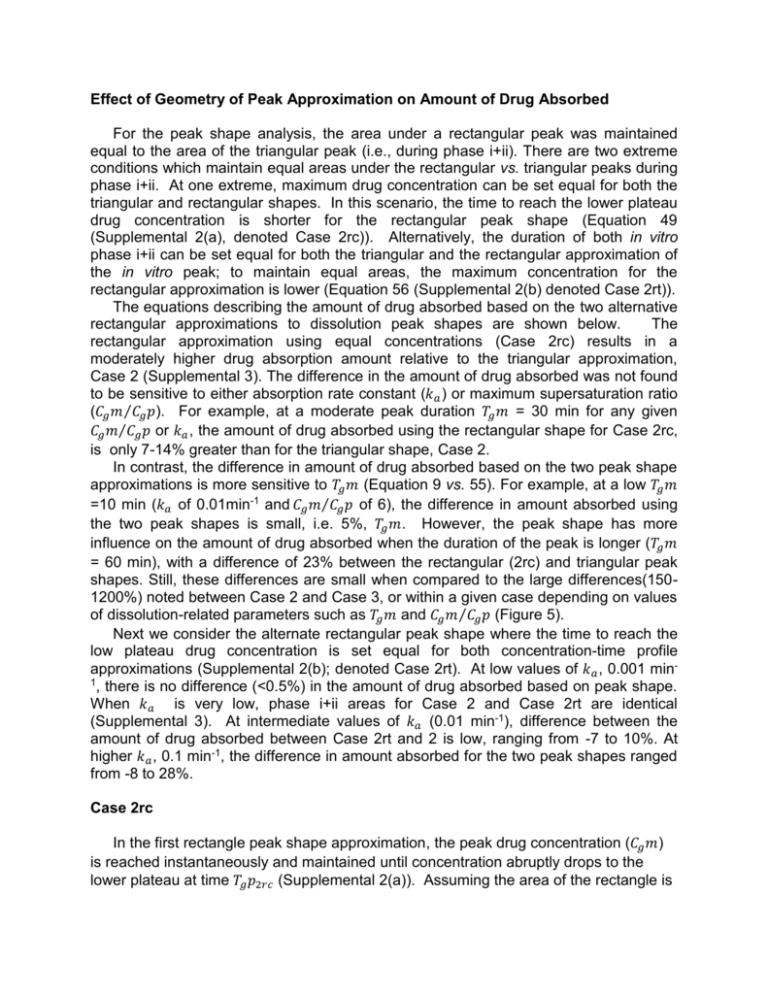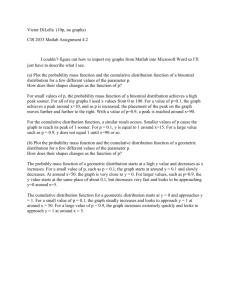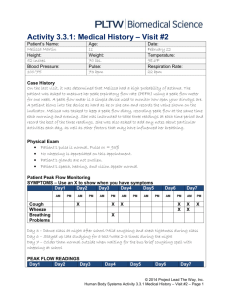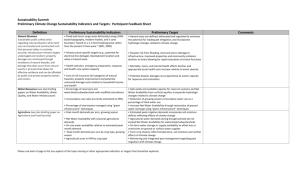Effect of Geometry of Peak Approximation on Amount of Drug
advertisement

Effect of Geometry of Peak Approximation on Amount of Drug Absorbed
For the peak shape analysis, the area under a rectangular peak was maintained
equal to the area of the triangular peak (i.e., during phase i+ii). There are two extreme
conditions which maintain equal areas under the rectangular vs. triangular peaks during
phase i+ii. At one extreme, maximum drug concentration can be set equal for both the
triangular and rectangular shapes. In this scenario, the time to reach the lower plateau
drug concentration is shorter for the rectangular peak shape (Equation 49
(Supplemental 2(a), denoted Case 2rc)). Alternatively, the duration of both in vitro
phase i+ii can be set equal for both the triangular and the rectangular approximation of
the in vitro peak; to maintain equal areas, the maximum concentration for the
rectangular approximation is lower (Equation 56 (Supplemental 2(b) denoted Case 2rt)).
The equations describing the amount of drug absorbed based on the two alternative
rectangular approximations to dissolution peak shapes are shown below.
The
rectangular approximation using equal concentrations (Case 2rc) results in a
moderately higher drug absorption amount relative to the triangular approximation,
Case 2 (Supplemental 3). The difference in the amount of drug absorbed was not found
to be sensitive to either absorption rate constant (𝑘𝑎 ) or maximum supersaturation ratio
(𝐶𝑔 𝑚⁄𝐶𝑔 𝑝). For example, at a moderate peak duration 𝑇𝑔 𝑚 = 30 min for any given
𝐶𝑔 𝑚⁄𝐶𝑔 𝑝 or 𝑘𝑎 , the amount of drug absorbed using the rectangular shape for Case 2rc,
is only 7-14% greater than for the triangular shape, Case 2.
In contrast, the difference in amount of drug absorbed based on the two peak shape
approximations is more sensitive to 𝑇𝑔 𝑚 (Equation 9 vs. 55). For example, at a low 𝑇𝑔 𝑚
=10 min (𝑘𝑎 of 0.01min-1 and 𝐶𝑔 𝑚⁄𝐶𝑔 𝑝 of 6), the difference in amount absorbed using
the two peak shapes is small, i.e. 5%, 𝑇𝑔 𝑚. However, the peak shape has more
influence on the amount of drug absorbed when the duration of the peak is longer (𝑇𝑔 𝑚
= 60 min), with a difference of 23% between the rectangular (2rc) and triangular peak
shapes. Still, these differences are small when compared to the large differences(1501200%) noted between Case 2 and Case 3, or within a given case depending on values
of dissolution-related parameters such as 𝑇𝑔 𝑚 and 𝐶𝑔 𝑚⁄𝐶𝑔 𝑝 (Figure 5).
Next we consider the alternate rectangular peak shape where the time to reach the
low plateau drug concentration is set equal for both concentration-time profile
approximations (Supplemental 2(b); denoted Case 2rt). At low values of 𝑘𝑎 , 0.001 min1, there is no difference (<0.5%) in the amount of drug absorbed based on peak shape.
When 𝑘𝑎 is very low, phase i+ii areas for Case 2 and Case 2rt are identical
(Supplemental 3). At intermediate values of 𝑘𝑎 (0.01 min-1), difference between the
amount of drug absorbed between Case 2rt and 2 is low, ranging from -7 to 10%. At
higher 𝑘𝑎 , 0.1 min-1, the difference in amount absorbed for the two peak shapes ranged
from -8 to 28%.
Case 2rc
In the first rectangle peak shape approximation, the peak drug concentration (𝐶𝑔 𝑚)
is reached instantaneously and maintained until concentration abruptly drops to the
lower plateau at time 𝑇𝑔 𝑝2𝑟𝑐 (Supplemental 2(a)). Assuming the area of the rectangle is
equal to the area of the triangle peak concentration, the peak duration for the Case 2rc
(𝑇𝑔 𝑝2𝑟𝑐 ) is:
𝐶 𝑝
𝑇𝑔 𝑝
𝑔
2
𝑇𝑔 𝑝2𝑟𝑐 = 𝑇𝑔 𝑚 − 𝐶 𝑔𝑚 (𝑇𝑔 𝑚 +
)
(49)
The concentration of drug in solution (𝐶𝑙 𝑠(𝑡)) is depleted by absorption as described
in Equation 50.
𝐶𝑙 𝑠(𝑡) = 𝐶𝑔 𝑚 −
𝑋𝑙 𝑎2𝑟𝑐𝑖+𝑖𝑖 (𝑡)
𝑉𝑙
(50)
Substituting Equation 50 into Equation 7 and integrating yields the time profile for the
amount of drug absorbed (𝑋𝑙 𝑎2𝑟𝑐𝑖+𝑖𝑖 (𝑡)) in phases i and ii.
𝑋𝑙 𝑎2𝑟𝑐𝑖+𝑖𝑖 (𝑡) = (𝑉𝑙 )(𝐶𝑔 𝑚)(1 − 𝑒 −(𝑘𝑎)(𝑡) )
(51)
At 𝑇𝑔 𝑝2𝑟𝑐 , the concentration 𝐶𝑙 𝑠(𝑡) drops to 𝐶𝑔 𝑝. However, in some cases depletion
due to absorption reduces the concentration, 𝐶𝑙 𝑠(𝑡) to 𝐶𝑔 𝑝 prior to 𝑇𝑔 𝑝2𝑟𝑐 . For these
cases, 𝑇𝑙 𝑝2𝑟𝑐 not 𝑇𝑔 𝑝2𝑟𝑐 , defines the end of phase i+ii. Combining Equations 50 and 51
at 𝑡 = 𝑇𝑙 𝑝2𝑟𝑐 , rearrangement yields:
𝑇𝑙 𝑝2𝑟𝑐 =
𝐶 𝑚
1
𝑙𝑛 ( 𝑔 )
𝑘𝑎
𝐶𝑔 𝑝
(52)
The amount of drug absorbed during phases i and ii (𝑋𝑙 𝑎2𝑟𝑐𝑖+𝑖𝑖 |𝑡0 ) for Case 2rc can
be found by substituting the smaller value, 𝑇𝑔 𝑝2𝑟𝑐 (Equation 49) or 𝑇𝑙 𝑝2𝑟𝑐 (Equation
52), for 𝑡 in Equation 51.
𝑋𝑙 𝑎|𝑡0 = (𝑉𝑙 )(𝐶𝑔 𝑚)(1 − 𝑒 −(𝑘𝑎)(𝑡) )
(53)
Once the lower plateau is reached, the concentration of dissolved drug remains
equal to 𝐶𝑔 𝑝 for the entire phase iii, as in Case 2. The total amount of drug absorbed
during phase iii is shown in Equation 54 (similar to Equation 37 in Case 2.)
𝑇𝑟
𝑋𝑙 𝑎2𝑟𝑐𝑖𝑖𝑖 |𝑡 𝑙 = (𝑘𝑎 )(𝑉𝑙 )(𝐶𝑔 𝑝)(𝑇𝑙 𝑟 − 𝑡)
(54)
where 𝑡 is 𝑇𝑔 𝑝2𝑟𝑐 or 𝑇𝑙 𝑝2𝑟𝑐 , whichever is smaller.
By adding Equation 53 and 54, the total amount absorbed for all three phases,
𝑇𝑟
𝑋𝑙 𝑎2𝑟𝑐 |0𝑙 is:
𝑇𝑟
𝑋𝑙 𝑎2𝑟𝑐 |0𝑙 = (𝑉𝑙 ){(𝐶𝑔 𝑚)(1 − 𝑒 −(𝑘𝑎)(𝑡) ) + (𝑘𝑎 )(𝐶𝑔 𝑝)(𝑇𝑙 𝑟 − 𝑡)}
(55)
where 𝑡 is 𝑇𝑔 𝑝2𝑟𝑐 or 𝑇𝑙 𝑝2𝑟𝑐 , whichever is the smaller.
Case 2rt
In the alternate rectangular peak shape approximation, the in vitro time to reach the
lower plateau concentration (𝑇𝑔 𝑝) is the same for both triangular and rectangular
approximations. While the maximum peak concentration for the triangular
approximation is 𝐶𝑔 𝑚, the maximum peak concentration using the rectangular
approximation a lower value, 𝐶𝑔 𝑚2𝑟𝑡 (Supplemental 2(b)) to maintain equal peak areas.
The lower value, 𝐶𝑔 𝑚𝑟𝑡 for the peak concentration is:
𝐶𝑔 𝑚2𝑟𝑡 = (
𝑇𝑔 𝑚
𝑇𝑔 𝑝
) (𝐶𝑔 𝑚 − 𝐶𝑔 𝑝) +
𝐶𝑔 𝑝
2
(56)
The amount of drug absorbed in phases i and ii (𝑋𝑙 𝑎2𝑟𝑡𝑖+𝑖𝑖 (𝑡)) can be found by mass
balance (Equation 57) which is analogous to Equation 27.
𝐶𝑙 𝑠(𝑡) = 𝐶𝑔 𝑚2𝑟𝑡 −
𝑋𝑙 2𝑟𝑡𝑖 + 𝑖𝑖(𝑡)
𝑉𝑙
(57)
Substituting Equation 57 into Equation 7 and integrating yields the time profile for the
amount of drug absorbed (𝑋𝑙 2𝑟𝑡𝑖+𝑖𝑖 (𝑡)) in phases i and ii.
𝑋𝑙 2𝑟𝑡𝑖+𝑖𝑖 (𝑡) = (𝑉𝑙 )(𝐶𝑔 𝑚2𝑟𝑡 )(1 − 𝑒 −(𝑘𝑎)(𝑡) )
(58)
At 𝑇𝑔 𝑝, the concentration, 𝐶𝑙 𝑠(𝑡) drops to 𝐶𝑔 𝑝. However, in some cases depletion
due to absorption reduces the concentration, 𝐶𝑙 𝑠(𝑡) to 𝐶𝑔 𝑝 prior to 𝑇𝑔 𝑝. For these
cases, 𝑇𝑙 𝑝2𝑟𝑡 and not 𝑇𝑔 𝑝, defines the end of phase i+ii. 𝑇𝑙 𝑝2𝑟𝑡 can be calculated by
combining Equations 57 and 58 and by recognizing that 𝑡 = 𝑇𝑙 𝑝2𝑟𝑡 , 𝐶𝑙 𝑠(𝑡) = 𝐶𝑔 𝑝.
1
𝐶𝑔 𝑚2𝑟𝑡
𝑇𝑙 𝑝2𝑟𝑡 = 𝑘 𝑙𝑛 (
𝑎
𝐶𝑔 𝑝
)
(59)
Since the approximated rectangle peak shape is the same area as the
corresponding approximated isosceles triangle, the amount of drug absorbed for phases
i and ii (𝑋𝑙 𝑎2𝑟𝑡𝑖+𝑖𝑖 |𝑡0 ) for Case 2rt can be found by substituting the smaller value, 𝑇𝑔 𝑝
(Equation 49) or 𝑇𝑙 𝑝2𝑟𝑡 (Equation 59), for 𝑡 in Equation 58.
𝑋𝑙 𝑎2𝑟𝑡𝑖+𝑖𝑖 |𝑡0 = (𝑉𝑙 )(𝐶𝑔 𝑚2𝑟𝑡 )(1 − 𝑒 −(𝑘𝑎)(𝑡) )
(60)
Again, the assumption for phase iii is the same as in Case 2rc and Case 2, where
once the lower plateau is reached, the concentration of dissolved drug remains equal to
𝐶𝑔 𝑝 for the entire phase. The total amount of drug absorbed for phase iii is:
𝑇𝑟
𝑋𝑙 𝑎2𝑟𝑡𝑖𝑖𝑖 |𝑡 𝑙 = (𝑘𝑎 )(𝑉𝑙 )(𝐶𝑔 𝑝)(𝑇𝑙 𝑟 − 𝑡)
(61)
where 𝑡 is 𝑇𝑔 𝑝 or 𝑇𝑙 𝑝2𝑟𝑡 , whichever is the smaller.
The total amount absorbed during all three phases is the sum of Equations 60 and
61.
𝑇𝑟
𝑋𝑙 𝑎2𝑟𝑡 |0𝑙 = (𝑉𝑙 ){(𝐶𝑔 𝑚2𝑟𝑡 )(1 − 𝑒 −(𝑘𝑎)(𝑡) ) + (𝑘𝑎 )(𝐶𝑔 𝑝)(𝑇𝑙 𝑟 − 𝑡)}
where 𝑡 is 𝑇𝑔 𝑝 or 𝑇𝑙 𝑝2𝑟𝑡 , whichever is the smaller.
(62)







